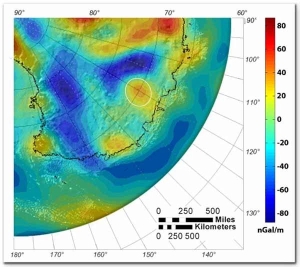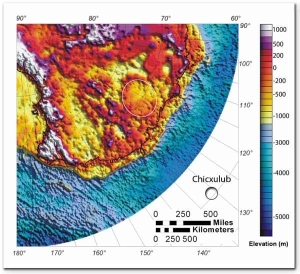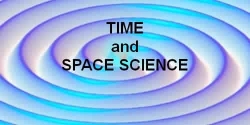Permian Extinction
Permian Extinction - the worst in history
The Permian Extinction - the worst
extinction in history
Significant extinctions
in the past
Studies suggesting the Permian
Extinction was Quick
A crater that could be the possible cause of
the Permian Extinction
The Permian Extinction
The Permian Extinction - the worst extinction in historyPrevious research showed the extinction wiped out nearly 90 percent of sea species and 70 percent of vertebrate animal species on land. That made it far worse than the Cretaceous-Tertiary extinction of the dinosaurs and many other creatures 65 million years ago an event often blamed on the impact of a perhaps 6-mile- (10-kilometer-) wide asteroid.
In the September 8 issue of the journal Science, Ward and colleagues concluded the Permian-Triassic catastrophe also stripped Earth of many rooted plants, triggering severe erosion.
As a result, sedimentary rocks from that time show that large meandering rivers throughout South Africas Karoo Basin took on a braided, multichannel appearance, resembling streams in areas devastated by Mount St. Helens big eruption or areas logged by clear-cutting.
Significant Extinctions in the Past
Cretaceous-Tertiary extinction,about 65 million years ago, probably caused or aggravated by impact of several-mile-wide asteroid that created the Chicxulub crater now hidden on the Yucatan Peninsula and beneath the Gulf of Mexico. Some argue for other causes, including gradual climate change or flood-like volcanic eruptions of basalt lava from Indias Deccan Traps. The extinction killed 16 percent of marine families, 47 percent of marine genera (the classification above species) and 18 percent of land vertebrate families, including the dinosaurs.
End Triassic extinction,
roughly 199 million to 214 million years ago, most likely caused by massive floods of lava erupting from the central Atlantic magmatic province -- an event that triggered the opening of the Atlantic Ocean. The volcanism may have led to deadly global warming. Rocks from the eruptions now are found in the eastern United States, eastern Brazil, North Africa and Spain. The death toll: 22 percent of marine families, 52 percent of marine genera. Vertebrate deaths are unclear.
Permian-Triassic extinction,
about 251 million years ago. Many scientists suspect a comet or asteroid impact, although direct evidence has not been found. Others believe the cause was flood volcanism from the Siberian Traps and related loss of oxygen in the seas. Still others believe the impact triggered the volcanism and also may have done so during the Cretaceous-Tertiary extinction. The Permian-Triassic catastrophe was Earths worst mass extinction, killing 95 percent of all species, 53 percent of marine families, 84 percent of marine genera and an estimated 70 percent of land species such as plants, insects and vertebrate animals.
Late Devonian extinction,
about 364 million years ago, cause unknown. It killed 22 percent of marine families and 57 percent of marine genera. Erwin said little is known about land organisms at the time.
Ordovician-Silurian extinction,
about 439 million years ago, caused by a drop in sea levels as glaciers formed, then by rising sea levels as glaciers melted. The toll: 25 percent of marine families and 60 percent of marine genera.
Studies Suggest - Permian Extinction Quick
Studies suggesting the permian extinction was quickThe new study is the latest in a series showing the Permian-Triassic catastrophe was quick at least in geological terms and extremely nasty.
But it has not settled debate among those who advocate various theories of what caused the extinction: an object whacking Earth, floods of lava from the Siberian Traps, climate change, and/or deadly radiation from a nearby supernova or other cosmic explosion.
In July, Doug Erwin of the Smithsonian Institutions National Museum of Natural History published a study in Science in which marine rocks from China revealed the Permian-Triassic extinction happened in less than 160,000 years.
And in Julys issue of the journal Geology, a study of seafloor rocks now in the Austrian Alps concluded the extinction happened in less than 60,000 years and perhaps in less than 8,000 years, said the main author, planetary scientist Michael Rampino of New York University.
Because the rock layers do not permit finer dissection of time, the findings are consistent with the extinction being triggered by an impact that happened during "a single bad day," Erwin said.
"The mass extinction at the end of the Permian Period was catastrophic and sudden," ravaging sea and land life, Rampino said. "The only thing we know of that can cause an extinction like this is a large impact of an asteroid or comet. But we still havent found conclusive evidence that an impact occurred."
Rampino said the object "would have to be bigger one and a half to twice as big" as the 6-mile- (10-kilometer-) wide asteroid usually blamed for the dinosaurs extinction.
In 1997, University of Oregon paleontologist Gregory Retallack reported finding elevated iridium levels and shocked quartz crystals in Permian-Triassic rocks telltale signs of an impact.
"Unfortunately, we have not found a good candidate crater," he said.
Ward said a comet made of ice "would be almost invisible geologically."
Australian scientists said they found a 75-mile- (120-kilometer-) wide crater in western Australia that might be from an impact that caused the Permian-Triassic extinction or a later extinction at the end of the Triassic Period roughly 200 million years ago.
But Rampino said the age of that crater is so poorly known that "it is impossible to tie that impact to this [Permian-Triassic] extinction."
Nevertheless, Retallack favors impact as the cause, perhaps with the impact triggering an undersea release of methane that robbed the oceans of life-sustaining oxygen. He says the impact also may have triggered massive eruptions from volcanic vents named the Siberian Traps.
"There is no evidence of an impact" at Permian-Triassic time, Erwin said. "So while the data are consistent with an impact, there is nothing that tells us it was an impact," and massive volcanic eruptions may be a more likely cause.
Rampino said the Siberian volcanic eruptions lasted hundreds of thousands of years, so "if the extinctions were gradual over a half million years, we might suspect volcanism or changes in climate caused by volcanic eruptions. But the fact the extinctions were so sudden and catastrophic argues against a volcanic interpretation."
Possible Cause of the Permian Extinction
A crater that could be the possible cause of the Permian ExtinctionAn apparent crater as big as Ohio has been found in Antarctica. Scientists think it was carved by a space rock that caused the greatest mass extinction on Earth, 250 million years ago.

The crater, buried beneath a half-mile of ice and discovered by some serious airborne and satellite sleuthing, is more than twice as big as the one involved in the demise of the dinosaurs.
The crater's location, in the Wilkes Land region of East Antarctica, south of Australia, suggests it might have instigated the breakup of the so-called Gondwana supercontinent, which pushed Australia northward, the researchers said.
"This Wilkes Land impact is much bigger than the impact that killed the dinosaurs, and probably would have caused catastrophic damage at the time," said Ralph von Frese, a professor of geological sciences at Ohio State University.
How they found it
The crater is about 300 miles wide. It was found by looking at differences in density that show up in gravity measurements taken with NASA's GRACE satellites. Researchers spotted a mass concentration, which they call a mascon—dense stuff that welled up from the mantle, likely in an impact.
"If I saw this same mascon signal on the Moon, I'd expect to see a crater around it," Frese said. (The Moon, with no atmosphere, retains a record of ancient impacts in the visible craters there.)
So Frese and colleagues overlaid data from airborne radar images that showed a 300-mile wide sub-surface, circular ridge. The mascon fit neatly inside the circle.

"And when we looked at the ice-probing airborne radar, there it was," he said today.
Smoking gun?
The Permian-Triassic extinction, as it is known, wiped out most life on land and in the oceans. Researchers have long suspected a space rock might have been involved. Some scientists have blamed volcanic activity or other culprits.
The die-off set up conditions that eventually allowed dinosaurs to rule the planet.
The newfound crater is more than twice the size of the Chicxulub crater in the Yucatan peninsula, which marks the impact that may have ultimately killed the dinosaurs 65 million years ago. The Chicxulub space rock is thought to have been 6 miles wide, while the Wilkes Land meteor could have been up to 30 miles wide, the researchers said.
Confirmation needed
Postdoctoral researcher Laramie Potts assisted in the discovery.
The work was financed by NASA and the National Science Foundation. The discovery, announced today, was initially presented in a poster paper at the recent American Geophysical Union Joint Assembly meeting in Baltimore.
The researchers say further work is needed to confirm the finding. One way to do that would be to go there and collect rock from the crater to see if its structure matches what would be expected from such a colossal impact.

